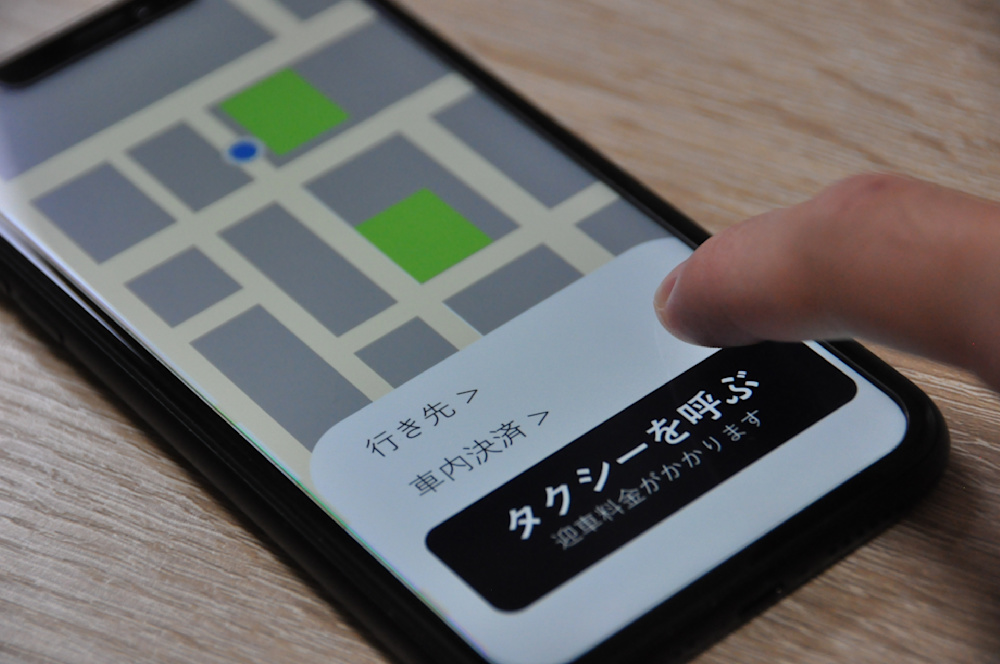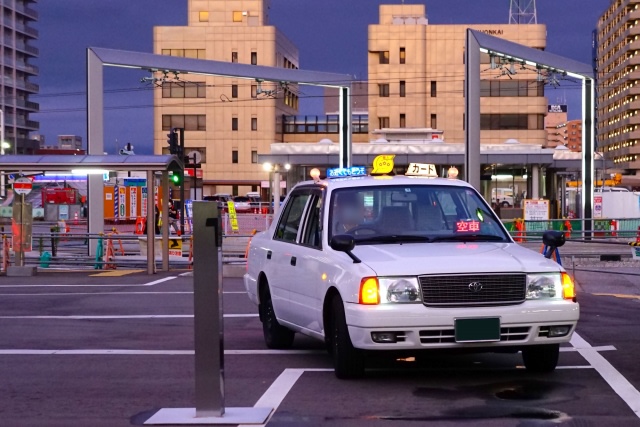Updated October 27, 2025
Taxis in Japan: How to Use Them in 2025
Japan is known for its elaborate and highly efficient train system. But trains can’t always get you where you need to go, especially in urgent situations. This is where taxis save the day.
Whether you're heading to a business meeting, carrying heavy luggage, or need transport after the last train, knowing how to book a taxi will make your life in Japan significantly easier.
This guide covers everything you need to know about reserving taxis in Japan: which apps work best, how to call for one by phone, what payment methods are accepted where, and some uniquely Japanese transport services that might surprise you.
In this article: 📝
How to Book Taxi in Japan for Foreigners
There are several ways to get a taxi in Japan, and your choice usually depends on where you are and how comfortable you feel speaking Japanese. Let's break down your options from most convenient to most traditional.
Using Taxi Apps
Apps have revolutionized taxi booking in Japan, especially for expats who don't speak fluent Japanese.
The GO app dominates the market with 80% market share among Japan's top 5 taxi apps, serving all of Japan's 47 prefectures. What makes it particularly useful for foreigners is its English interface and acceptance of overseas phone numbers and credit cards.
The process is simple: Just download the app, register your details, set your pickup location, choose your destination, and request a taxi. The AI Reservation feature can get you a taxi within 15 minutes in most urban areas.
S.RIDE: S.RIDE offers another solid option with its intuitive swipe interface and 95% success rate in dispatching vehicles thanks to advanced AI demand forecasting. Both apps work similarly to Uber if you're familiar with that system.
GO PREMIUM: This service deserves special mention if you're traveling in a group. Available in 15 Tokyo wards, it lets you request luxury vans with seating for up to six people, making it perfect for airport runs or group outings.
Calling a Taxi by Phone
Phone booking is still quite common in Japan, especially outside major cities. Most large taxi companies in urban areas have English-speaking operators, but knowing some basic Japanese phrases helps everywhere else.
Here's what taxi operators typically ask for:
Pickup location
Time (if booking in advance)
Destination
Your name
Contact phone number
Keep in mind that each taxi company covers specific areas based on their own policies, not entire prefectures. Always confirm they service both your pickup location and destination before booking.
Finding Taxis on the Street and at Taxi Stands
The traditional approach of hailing a cab on the street still works well in busy areas. Taxis display colored signs in red, green, and orange on their front windows. Here’s how to decipher them:
空車 (Kūsha) - Red: Available
賃走 (Chinsō) - Green: Occupied
回送 (Kaisō) - Orange: Not in service
迎車 (Geisha) - Orange: En route to pickup
予約車 (Yoyakusha) - Orange: Reserved
As you can see, Orange has three meanings, but they all simply mean that the taxi isn’t available to you. Taxi stands are usually located at train stations, shopping centers, airports, and major tourist spots. If you see one, simply join the queue and wait for your turn.
Essential Japanese Phrases for Taxi Reservations: How to Call a Taxi in Japanese
Even with English-friendly apps available, knowing some basic Japanese can be a lifesaver, especially when calling smaller companies or dealing with drivers who don't speak English.
Here’s a simple Japanese sentence you can use when making a reservation:
"I'd like to reserve a taxi at (time)." (時間)時にタクシーを予約したいです - (Jikan) ji ni takushi wo yoyaku shitai desu
Here’s how you can provide some pickup instructions to your driver if you have any:
"Please pick me up at (location)." (場所)に迎えにきてください - (Basho) ni mukae ni kite kudasai
"I would like to go to (location)" (場所)に行きたいです - (Basho) ni ikitai desu
Of course, you’ll also need some handy phrases during your ride. Here are a few useful examples:
"How long will it take?" – どれぐらいかかりますか?(Dore gurai kakarimasu ka?)
"How much will it cost?" – いくらですか?(Ikura desu ka?)
"Please stop here." – ここで止めてください (Koko de tomete kudasai)
Best Websites and Services for Booking Taxis: How to Book a Taxi in Japan Online

In addition to the apps, several websites also offer taxi booking services across Japan. Each has different coverage areas, booking requirements, and vehicle options. Here's what you need to know about the major players.
Multi-City Services
MK Taxi operates across Kyoto, Osaka, Kobe, Shiga, Sapporo, Nagoya, Tokyo, and Fukuoka. They offer online booking (expect several business days for confirmation) and various vehicle sizes, including larger options for groups or families with lots of luggage.
Welcome Pickups serves Osaka, Sapporo, and Tokyo, but booking in advance is required. They're particularly popular for airport transfers and specialize in English-speaking drivers.
Jumbo Taxi focuses exclusively on large vehicles and operates in Saitama, Tokyo, plus airport transfers to Narita and Haneda. If you're traveling with a group or have significant luggage, this is your best bet.
Tokyo-Specific Options: How to Book a Taxi in Tokyo
When it comes to taxi services, Tokyo offers the most variety:
Tokyo MK provides premium service throughout the metropolitan area.
Hinomaru Tokyo offers both regular taxis and tourist services.
Nihon Kotsu runs one of Japan's largest taxi fleets.
Osaka-Specific Options: How to Book a Taxi in Osaka
If you’re living in Osaka, your options include the following services:
MK Taxi Osaka (English booking available).
Kinki Nippon Tourist (regular taxi and tourist hire services).
Kintetsu Taxi (Japanese language only).
For large taxis in major cities, GO and S.RIDE apps give you the most flexibility since you can choose vehicle size during booking.
Understanding Taxi Fare Calculation
Japan's taxi pricing follows a standardized structure, though rates vary by region and company. Understanding how fares work helps you budget appropriately and avoid surprises.
Standard Pricing Structure
In central Tokyo, the flagfall rate starts at 500 yen for the first kilometer. After that, you pay approximately 100 yen for every 255 meters traveled, or 100 yen for every 85 seconds when moving under 10 km/h (like in heavy traffic).
Here’s a breakdown of what a typical fare includes:
Initial fare: 400-750 yen for the first 1-2 kilometers.
Distance charges: 80-100 yen per 200-400 meters.
Time-based charges: When stationary or moving slowly.
Highway tolls: Added separately when applicable.
In addition to these, there’s also the night surcharge. All taxi companies charge 20% extra between 10:00 PM and 5:00 AM. This is standard practice across Japan, so don’t try to argue with your driver or assume that they’re scamming you.
Airport Fixed Rates
Many companies offer fixed rates for airport transfers. GO app's Airport Flat Rate charges from 8,800 yen for Tokyo to Haneda and from 28,400 yen to Narita (plus highway tolls and a 400 yen service fee). These can be more economical than metered fares during peak traffic times.
For reference, a typical 7-kilometer Tokyo ride taking 25 minutes costs 2,500-3,000 yen during daytime hours.
Payment Methods for Taxis in Japan: Do Taxis Take Credit Cards?
Many new payment options have been introduced in recent years, but keep in mind that payment method availability varies by location and company. Here's what you can expect in different situations.
Urban vs Rural Payment Options
In major cities like Tokyo, Osaka, and Kyoto, multiple payment methods are available everywhere you go. This often includes:
Credit cards (Visa, Mastercard, JCB widely accepted)
IC cards (Suica, PASMO, ICOCA)
QR code payments (PayPay, d-payment)
Mobile payments (Apple Pay through apps)
Cash (always accepted)
In the countryside, or inaka, you’ll likely have limited options:
Cash is accepted everywhere outside major cities.
Credit cards are way less common than in the city, so beware.
IC Cards are even less commonly accepted than credit cards.
App-Based Payments
GO app users can register credit cards or link Apple Pay for automatic payment. When you reach your destination, you simply get out and walk away.
S.RIDE offers a similar type of convenience with their S.RIDE WALLET system, which works even with street-hailed taxis if they have the QR code system.
When in doubt, check for stickers on taxi windows before getting in. They usually display which payment types are accepted.
Here are a few important reminders:
No tipping required (tipping isn’t customary in Japan).
Try to avoid paying small fares with large bills.
Night surcharge applies everywhere (20% extra from 10 PM to 5 AM).

What is Daiko Taxi Service in Japan?
Daiko represents one of Japan's most practical transportation solutions that most expats don't know about.
The service solves a specific problem: What do you do when you've driven somewhere and want to drink, but need both yourself and your car to get home safely?
How Daiko Actually Works
The name “Daiko” comes from Japanese characters meaning "in place of" (dai) and "to go" (ko). In Japanese, it's 運転代行サービス (Unten Daiko Service).
The process is quite simple: You call for a Daiko service, and two drivers arrive in a small car. One driver takes the wheel of your car with you as a passenger, while the second driver follows in the Daiko company vehicle. When you reach your destination, both drivers leave together in the company car.
Where and When to Use Daiko Service Japan
Daiko service is most common in countryside areas where people depend on cars for transportation and public transit options are limited, especially after dark. However, you'll find it in cities too, particularly in suburban areas.
Business hours can vary by company, but Daiko typically runs until late at night. Some operate 24/7, depending on location. Peak hours are 8:00 PM to 2:00 AM, so expect longer wait times during these periods.
Here’s how you can arrange Daiko:
Ask the restaurant or bar staff to call Daiko for you.
Look for Daiko cars waiting near nightlife areas.
Call directly if you have a local number.
Daiko typically costs about 1.5 times a regular taxi fare, which is still much cheaper than dealing with a DUI charge.
City-Specific Booking Tips
Different Japanese cities have their own taxi ecosystems and quirks. Here's what you need to know for some of the biggest cities.
How to Reserve a Taxi in Tokyo
Tokyo offers the most expat-friendly taxi options in Japan. GO app coverage is excellent, and many drivers in central areas have basic English skills. The GO PREMIUM service works well for groups, covering 15 wards with luxury van options.
For airport transfers, fixed-rate options often beat metered fares, especially during rush hour traffic. Both Haneda and Narita have dedicated taxi areas with clear English signage.
How to Book a Taxi in Osaka
Osaka's system works similarly to Tokyo's but with slightly different companies leading the market. MK Taxi is particularly strong here and offers good multilingual support. Both the GO and S.RIDE apps function well throughout Kansai.
The city's narrow streets in traditional areas make taxis essential for reaching some restaurants and attractions that aren't within walking distance of train stations.
Booking in Other Cities
Of course, in smaller cities and rural areas, you’ll find that taxis work a little differently. Here are some things to watch out for:
Cash-only payments are common.
English support decreases significantly.
Having destinations written in Japanese is preferred.
Daiko services are more relevant and available.
Before we move on to your alternative options, here’s a Kyoto-specific warning: The city center gets extremely crowded during peak tourist seasons. Apps work well, but expect longer wait times during cherry blossom and autumn foliage periods.
Alternative Transportation Options
If you're looking for other options, you might be wondering whether Uber exists in Japan. It does, but it works quite differently from other countries.
For shorter urban distances, electric scooters are becoming increasingly popular in Japan, especially for quick trips where trains aren’t practical.
You can learn more about these two options in our dedicated articles.

Conclusion on How to Reserve a Taxi in Japan: Making Taxi Travel Work for You
Japan has a spectacular train system, and in big cities like Tokyo, you might think you’ll never need a taxi. But when emergencies pop up, or you’re stuck late at night, knowing how to get a ride fast can sometimes be a matter of life and death.
Thankfully, apps like GO and S.RIDE have made the process much more accessible, eliminating most language barriers and payment complications. Here are a few key takeaways:
Consider the Daiko service when going to social events.
The GO app works in English across 47 prefectures.
Night surcharges add 20% between 10 PM and 5 AM.
Payment options vary dramatically between urban and rural areas.
Fixed airport rates can save money during peak traffic.
With these tips, you’re ready to tackle Japan’s taxi system and make the most of your travels, no matter where you are in the country.
Get Job Alerts
Sign up for our newsletter to get hand-picked tech jobs in Japan – straight to your inbox.








